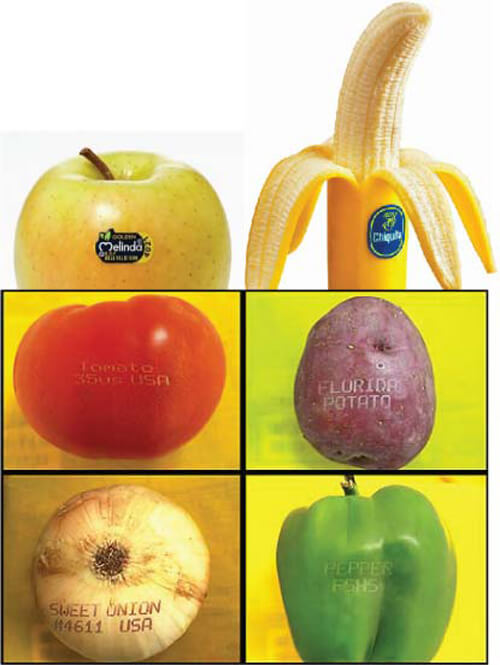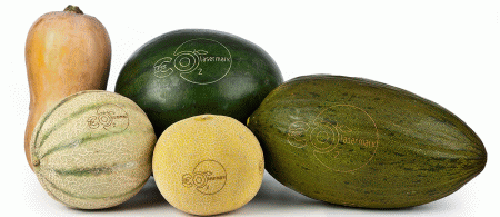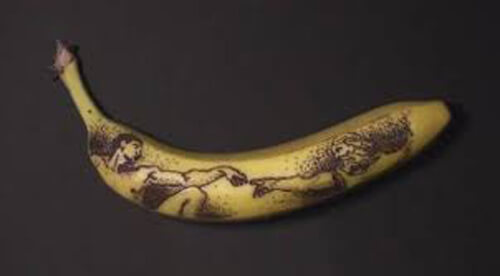Un packaging naturale quello della frutta e degli ortaggi: la sua buccia, che custodisce un tesoro ricco di vitamine, sali minerali e zuccheri. Le regole della distribuzione commerciale impongono (giustamente) la tracciabilità dei prodotti ortofrutticoli, e spesso questo tipo di dati riguardanti il frutto che ci apprestiamo a consumare è affidato a un’etichetta adesiva su cui si trova un codice a barre e qualche altra informazione – che tra l’altro può facilmente essere sostituita con una contraffatta o addirittura andare perduta.
Addio quindi ai bollini di carta appiccicati sui prodotti ortofrutticoli: arrivano i tatuaggi laser! È tutto vero e la notizia è stata pubblicata sulla Gazzetta Ufficiale dell’Unione Europea, che ha appositamente modificato l’elenco degli additivi alimentari inserendovi quelli che consentono di imprimere scritte, codici e anche immagini sulla buccia.
L’azienda spagnola Laser Food, in collaborazione con l’università di Valencia sta mettendo a punto una tecnologia che marchia ogni singolo frutto o ortaggio con un tatuaggio laser senza effetti secondari sulla qualità della polpa o della buccia. L’invenzione sarebbe una risposta straordinaria a uno dei maggiori problemi nell’industria agroalimentare: la totale tracciabilità di frutta e ortaggi, per singolo pezzo di merce, fino all’arrivo sulla tavola del consumatore.
La tecnica di tatuaggio non utilizza pressione per stampare fisicamente il frutto (si avrebbero altrimenti ammaccature o altri danni superficiali sui frutti), bensì la depigmentazione della superficie con successiva applicazione di un liquido di contrasto composto da ossidi e idrossidi di ferro, che rendono visibile la marchiatura senza implicare una penetrazione. Le sostanze ammesse per tatuare la frutta, secondo quanto riportato sulla Gazzetta Ufficiale Ue, sono “ossidi e idrossidi di ferro (E 172) come intensificatori del contrasto, l’idrossi-propil-metilcellulosa (E 464) come agente di rivestimento e i polisorbati (E 432 – 436) come emulsionanti nella preparazione di intensificatori del contrasto, allo scopo di aumentare il contrasto e consentire la marcatura indelebile (…) Gli ossidi e idrossidi di ferro (E 172) producono un contrasto sufficiente delle aree marcate con il resto della superficie della frutta, l’idrossi-propil-metilcellulosa (E 464) forma una sottile membrana protettiva sulle aree marcate e i polisorbati (E 432 – 436) assicurano una dispersione omogenea della preparazione di additivi alimentari sulle aree marcate degli alimenti”
come emulsionanti nella preparazione di intensificatori del contrasto, allo scopo di aumentare il contrasto e consentire la marcatura indelebile (…) Gli ossidi e idrossidi di ferro (E 172) producono un contrasto sufficiente delle aree marcate con il resto della superficie della frutta, l’idrossi-propil-metilcellulosa (E 464) forma una sottile membrana protettiva sulle aree marcate e i polisorbati (E 432 – 436) assicurano una dispersione omogenea della preparazione di additivi alimentari sulle aree marcate degli alimenti”
L’Ue ha altresì stabilito che il tatuaggio possa essere applicato solo sulla frutta di cui non viene consumata la buccia, e l’ha anche elencata: si tratta di agrumi, meloni e melagrane; la vecchia etichetta di carta non è vietata e la sostituzione col tatuaggio laser è volontaria.Il software attualmente utilizzato per la marchiatura è anche totalmente personalizzabile e, oltre alle informazioni tecniche può includere loghi e perfino auguri natalizi. L’etichettatura al laser è anche a prova di manomissione. Infatti, il marchio è praticamente permanente. La nuova tecnologia elimina le spese di adesivi e di stampe delle etichette, è ecocompatibile, e permette di etichettare 14 pezzi al secondo. Riusciremo ad abituarci a vedere anche la frutta tatuata come è oggi di moda fra le persone?
C’è però chi ha pensato ancora prima dell’UE di tatuare la frutta, e non per scopi logistici. Si tratta di Phil Hansen è un’ uomo che per divertimento tatua le banane, praticando dei piccoli fori sulla superficie della pelle del frutto riesce a far apparire le immagini che desidera [guarda il video]. Phil Hansen ha creato un libro “Tattoo a Banana” in cui insegna questa tecnica, e mette a disposizione disegni preimpostati per tatuare. Il sito di Phil in cui insegna come tatuare le banane ed altri oggetti: Phil in tre Whaaat (PITW): Creativity Fusion
[en]
A packaging that of natural fruits and vegetables: its peel, which contains a treasure trove rich in vitamins, minerals and sugars. The rules require commercial distribution (rightly) the traceability of fruit and vegetables, and often this type of data on the fruit we are about to consume is entrusted to an adhesive label on which there is a bar code and some other information – that between the other can easily be replaced with a counterfeit or even lost.
Farewell then to the paper stickers plastered on fruits and vegetables: get tattoos laser! It’s all true, and the news was published in the Official Journal of the European Union , which has specially modified the list of food additives by including those that allow you to give written codes as well as images on the peel.
The Spanish company Laser Food , in collaboration with the University of Valencia is developing a technology which marks each fruit or vegetable with a laser tattoo without side effects on the quality of the pulp or peel. The invention would be an extraordinary response to a major problem in the food industry: full traceability of fruit and vegetables, for each piece of merchandise, until the arrival of the consumer’s table.
The technique of tattooing does not use pressure to physically print the result (it would otherwise have dents or other damage on the fruit surface), but the discoloration of the surface with subsequent application of a contrast medium consisting of oxides and hydroxides of iron, which make visible the marking without implying a penetration. Substances allowed to tattoo fruits, as reported in the Official Gazette EU are ” oxides and hydroxides of iron (E 172) as an intensifier contrast, the hydroxy-propyl-methyl cellulose (E 464) as a coating agent and polysorbates ( E 432-436) as emulsifiers in the preparation of intensifier contrast, in order to increase the contrast and allow the indelible marking (…) The oxides and hydroxides of iron (E 172) produce a sufficient contrast of the marked areas with the rest of the surface fruit, hydroxy-propyl methyl cellulose (E 464) forms a thin protective membrane on the areas marked and polysorbates (E 432-436) provide a homogeneous dispersion of the preparation of food additives on the labeled areas of food “
The EU has also stated that the tattoo can be applied only on the fruit of which is not consumed in their skins, and also listed: these are citrus fruits, melons and pomegranates; old paper label is not prohibited and replacement with laser tattoo is voluntary. The software is currently used for marking is also fully customizable and, in addition to technical information can include logos and even Christmas cards. The labeling laser is also tamper proof. In fact, the brand is practically permanent. The new technology eliminates the expense of adhesives and prints the labels, is environmentally friendly and allows you to label 14 pieces per second. Will we get used to seeing even the fruit tattooed as is now fashionable among the people?
But there are those who thought even before the EU to tattoo fruits, and not for logistical purposes. This is Phil Hansen is a ‘man for fun tattoo bananas, practicing small holes on the surface of the skin of the fruit is able to make images appear to want to [ watch the video ]. Phil Hansen has created a book “Tattoo Banana” that teaches this technique, and provides pre-set designs for tattoos. The site where Phil teaches how to tattoo bananas and other objects: Phil in three Whaaat (PITW): Creativity Fusion
Mariangela Martellotta



